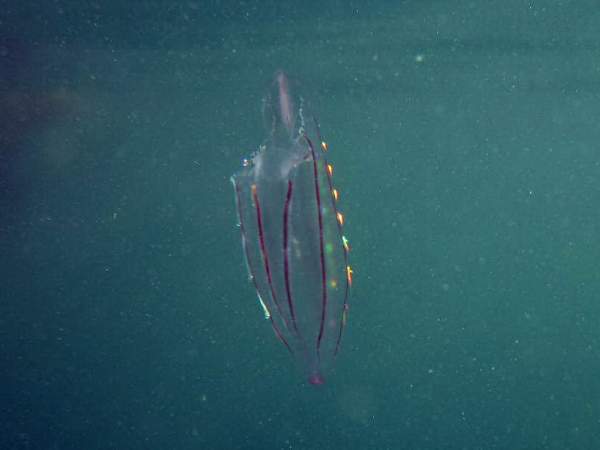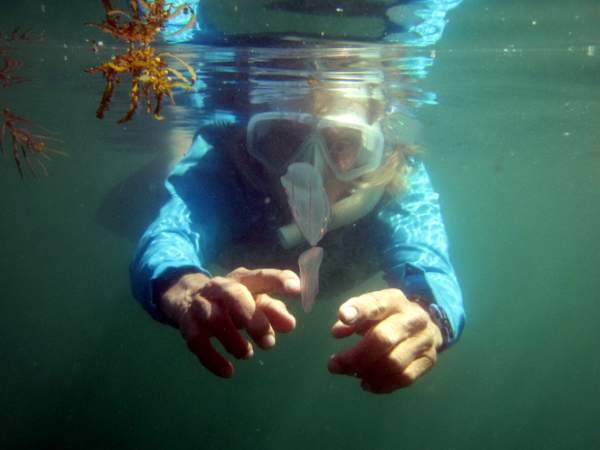Published in the Ocean Watch column, Honolulu Star-Advertiser © Susan Scott
May 24, 2010
When Craig pointed out the commotion surrounding our little rubber dinghy, I nearly fell out of it. Hanging over the side, we watched as millions of jelly things danced around the boat creating sparkles of rainbow-colored light. Individuals in the swarm ranged from the size of raspberries to thumb-size. All were semitransparent cylinders, with one end rounded and closed, the other end open like a bag.

“Do you know what they are?” Craig said as we watched the iridescent colors flash up and down the animals’ bodies.
It was one of the few times I remembered the scientific name of an animal but couldn’t come up with the common name. “Ctenophores [TEEN-o-fours],” I said. Only later, after looking them up, did I realize I’d seen my first comb jellies.
The “combs” of these jellyfish relatives are eight strips that run from the top end of the sack-type body down the sides to the open end. Both sides of each strip hold hairlike structures called cilia, each one resembling a tooth of a comb. The hairs constantly move back and forth, paddling the jellies through the water. Since the hairs are close together, they act like crystals, or prisms, separating sunlight into its spectrum of colors.
Comb Jellies at the Monterey Bay Aquarium, courtesy of Scott R. Davis
On a sunny day the result of this living light show is enough to excite even the most seasoned oceangoer — or cause her to jump over the side of a little boat. I did both. We swam with, handled and took pictures of the creatures until we were waterlogged.
This was possible because comb jellies don’t sting or bite human skin. They’re murder, though, on animal plankton, eating up to 10 times their weight per day.

Most comb jellies catch drifting prey by squirting glue on them, thus making them immobile. The ones I found, sometimes called melon comb jellies, eat each other. Stiff hairs (invisible to me) line those sack openings and act like tiny teeth. The comb jelly opens wide, bites down and swallows all or part of its neighbor.
About 100 species of comb jellies inhabit the world’s oceans, inshore to offshore, surface to great depths, pole to pole. Some are barely visible; others grow to 59 inches long.
Only a few comb jelly species have been well studied. Most are too fragile to collect, and even though they’re considered abundant, they don’t show up regularly in any one place. My melon comb jellies happened to be in the Sea of Cortez, also known as the Gulf of California, but I could have seen this cosmopolitan species anywhere.

The comb jelly people know best is the warty comb jelly. In the 1980s a ship accidentally transported this species to the Black Sea, resulting in disaster. With no natural predators (jellyfish, sea turtles and some fish) the warty combs multiplied, gobbling up fish eggs and larvae until the fisheries collapsed.
Researchers were stumped for solutions. Then the melon comb jelly was also accidentally introduced the same way. That species is now busy eating the copious warts, giving the Black Sea a chance for recovery.
I don’t know why the scientific name of these creatures stuck in my mind, but something about their biology must have impressed me. After swimming with the perky little comb jellies and watching their rainbow ribbons flash up and down their sides, I’m more than impressed. I’m smitten for life.
